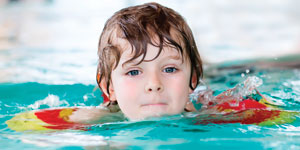School
3 min Read
How to encourage your reluctant swimmer

March 20, 2017
School
3 min Read

March 20, 2017


Melanie Oliver* of Cambridge, Ont. used to get a sinking feeling when her son Wyatt* would bring home an invitation to a friend’s pool party. “He always asked me to come up with an excuse why he couldn’t go,” she says. “He was too embarrassed to admit he couldn’t swim as well as the other kids.”
Swimming was a struggle for Wyatt from the start. “He was fearful and did not trust himself or the instructors,” Melanie remembers. “He would not release his muscles or let his body float. He just seemed to panic and sink.”
Although Melanie persisted with the lessons, Wyatt’s progress was slow and he remained hesitant in the water. It caused further problems when he was unable to pass the swim test at a summer camp and had to sit on the pool deck during the aquatic portion of the day.
According to Barbara Byers, Public Education and Research Director for the Lifesaving Society, kids who are natural risk-takers will typically progress more quickly in swimming, whereas cautious types may need more time. “It’s really more mental than physical, and it depends on the child’s temperament,” Barbara says. She recalls witnessing this with her own children: “One of them was fearless, while another was more of a ‘thinker’ who liked to be in control. For him, the notion of going underwater and not being able to breathe was unsettling.”
Communicating with kids about swimming and water play is tricky because of the inherent mixed messages. Of course, it’s meant to be a fun and enjoyable activity, but we also have to be extremely vigilant about safety. In the interest of drowning prevention, the Lifesaving Society operates Swim to Survive, a national school-based water safety program for Grade 3 students that teaches the skills needed to survive an unexpected fall into water. The program’s three key elements are recovering from a deep-water entry, treading water for one minute, and being able to swim 50 metres.
As the eight- and nine-year-olds attend the Swim to Survive sessions, Barbara notes that there is a wide range of swimming proficiency among the students. “We try to dial down the pressure and encourage the participants to progress at their own pace,” she says. “The swim instructors are well-trained and have supportive ways of assisting kids who may feel apprehensive.”
In Wyatt’s case, private lessons helped improve his skills, but he remained reluctant to swim without a flotation device. Melanie remembers a major turning point when he was playing in a pool with some friends. “They were playing a game where they tried to take away each other’s pool noodles,” she recalls. “Wyatt was trying so hard to keep up, and when he lost his noodle it was a ‘sink or swim’ moment. He found the courage to swim, and afterwards he was so proud.”
As with any physical skill, such as skating or riding a bike, some kids will have a natural aptitude for swimming without much instruction or prompting. Others may take a little longer to grasp the movement patterns and the mindset needed to work with the water, rather than against it. If your child is in this category, try to remind them (and yourself) to be patient and go with the flow.
*Names have been changed.
Originally published in ParentsCanada magazine, Spring 2017.